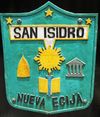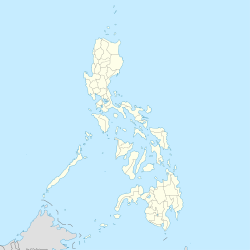San Isidro is a second class municipality in the province of Nueva Ecija, Philippines. According to the 2010 Philippine census, it has a population of 47,800 people.[3]
The town is bounded by Gapan City to the east, the municipalities of San Leonardo and Jaen to the north, San Antonio to the west, Cabiao to the southwest, San Miguel, Bulacan, to the southeast and Candaba, Pampanga, to the south.
San Isidro became the capital of the Philippines while Emilio Aguinaldo was trying to escape from the Americans.
Barangays
San Isidro is divided into 9 barangays.[2]
- Alua
- Calaba
- Malapit
- Mangga
- Poblacion
- Pulo
- San Roque
- Sto. Cristo
- Tabon
- Barangka
History
San Isidro was the capital of Nueva Ecija from 1850 to 1917. In 1896, the revolucionarios from Cabiao secretly marched to San Isidro to attack the Spanish provincial government. Today the victory is known as the First Cry of Nueva Ecija, the province is recognized as one of the first of the eight provinces that revolted against Spain.
In 1899, General Emilio Aguinaldo declared San Isidro as the capital of the Philippines after the revolutionary capital Malolos, Bulacan was captured by the Americans, this, however, was short lived. It was also in San Isidro that General Frederick Funston planned the capture of Aguinaldo to end the Philippine-American War.
The Wright Institute, established in 1903 in San Isidro, was one of the first high schools established outside Manila during the American period.
The town was occupied by Japanese troops in 1942, during the second world war. The combined U.S. and Philippine Commonwealth ground forces liberated San Isidro and defeated the Japanese forces in 1945 during the end of the war.
Demographics
| Population census of San Isidro |
| Year |
Pop. |
±% p.a. |
| 1990 |
34,349 |
— |
| 1995 |
36,283 |
+1.03% |
| 2000 |
40,984 |
+2.65% |
| 2007 |
44,687 |
+1.20% |
| 2010 |
47,800 |
+2.48% |
| Source: National Statistics Office[3] |
Images
|
|
|
San Isidro Labrador Church
|
|
|
|
M.R.P.F. Paulino Escalada 1836 bells
|
|
|
|
Nueva Ecija University of Science and Technology
|
|
|
|
The Crispulo Sideco (also known as Kapitang Pulong) house was built in the 19th century. Built in the Floral period in the Philippine colonial architecture, ogee arches, filigreed wooden panels, grilles wrought in curlicues and floral and foliate designs abound in the house as basic structural elements or as ornaments.
|
|
References
- ↑ Lua error in package.lua at line 80: module 'strict' not found.
- ↑ 2.0 2.1 Lua error in package.lua at line 80: module 'strict' not found.
- ↑ 3.0 3.1 3.2 Lua error in package.lua at line 80: module 'strict' not found.
External links
 |
Wikimedia Commons has media related to [[commons:Lua error in Module:WikidataIB at line 506: attempt to index field 'wikibase' (a nil value).|Lua error in Module:WikidataIB at line 506: attempt to index field 'wikibase' (a nil value).]]. |



